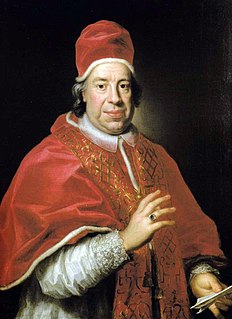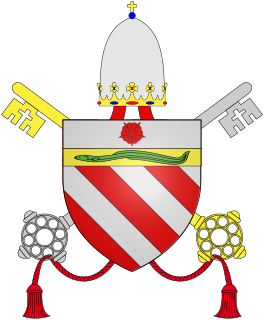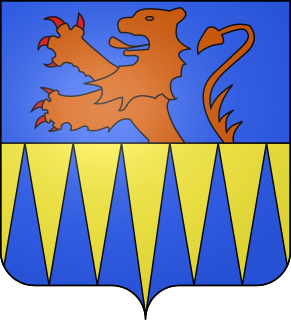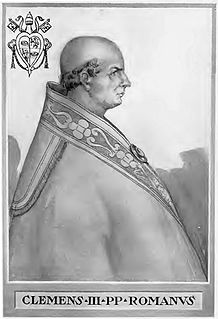
Pope Alexander IV was head of the Catholic Church and ruler of the Papal States from 12 December 1254 to his death in 1261.

Pope Innocent III, born Lotario dei Conti di Segni, held office from 8 January 1198 to his death.

Pope Innocent XIII, born as Michelangelo dei Conti, was head of the Catholic Church and ruler of the Papal States from 8 May 1721 to his death in 1724. He is the last pope to date to take the pontifical name of "Innocent" upon his election.

Pope Nicholas III, born Giovanni Gaetano Orsini, was head of the Catholic Church and ruler of the Papal States from 25 November 1277 to his death.
Conti is an Italian surname.
The Camerlengo of the Holy Roman Church is an office of the papal household that administers the property and revenues of the Holy See. Formerly, his responsibilities included the fiscal administration of the Patrimony of Saint Peter. As regulated in the apostolic constitution Pastor bonus of 1988, the camerlengo is always a cardinal, though this was not the case prior to the 15th century. His heraldic arms are ornamented with two keys – one gold, one silver – in saltire, surmounted by an ombrellino, a canopy or umbrella of alternating red and yellow stripes. These also form part of the coat of arms of the Holy See during a papal interregnum. The camerlengo has been Kevin Farrell since his appointment by Pope Francis on 14 February 2019. The vice camerlengo has been Archbishop Ilson de Jesus Montanari since 1 May 2020.
Papal coats of arms are the personal coat of arms of popes of the Catholic Church. These have been a tradition since the Late Middle Ages, and has displayed his own, initially that of his family, and thus not unique to himself alone, but in some cases composed by him with symbols referring to his past or his aspirations. This personal coat of arms coexists with that of the Holy See.

The Fieschi were a noble merchant family from Genoa, Italy, from whom descend the Fieschi Ravaschieri Princes of Belmonte. Of ancient origin, they took their name from the progenitor Ugo Fliscus, descendants of the counts of Lavagna.

Prince of Belmonte is a noble title created in 1619 by the Spanish crown for the Barons of Badolato and Belmonte. The name of the title is taken from the fortress town of Belmonte in Calabria, historically important for the defence of the Italian coast from Saracen invasion. Belmonte has been known since the Risorgimento as Belmonte Calabro.

Benedetta was the daughter and heiress of William I of Cagliari and Adelasia, daughter of Moroello Malaspina. She succeeded her father in January or February 1214.

Giovanni dei Conti di Segni was an Italian cardinal and cardinal-nephew of Pope Innocent III, his cousin, who elevated him in 1200 with the deaconry of Santa Maria in Cosmedin. He was also Chancellor of the Holy Roman Church 1205–1213 and Protodeacon of the Sacred College from 1210 or 1211.
Ottaviano dei Conti di Segni was an Italian cardinal and cardinal-nephew of Pope Innocent III, his cousin who elevated him probably in May 1206. He was canon of the Vatican Basilica, Camerlengo of the Holy Roman Church and protodeacon of the Sacred College of Cardinals.

The Torre dei Conti is a medieval fortified tower in Rome, Italy, located near the Colosseum and the Roman Forum. The tower was one of the most impressive towers that dominated medieval Rome.
The Conti di Marsi, the Counts of Marsi, were a lineage of Frankish origin who figured among the main feudal lords of Abruzzo, part of the Duchy of Spoleto in southern Italy, during the eleventh and twelfth centuries.

The 1198 papal election was convoked after the death of Pope Celestine III; it ended with the election of Cardinal Lotario dei Conti di Segni, who took the name Innocent III. In this election for the first time the new pope was elected per scrutinium.
Cardinal Conti may refer to:
Andrea dei Conti was an Italian Roman Catholic priest and a professed member of the Order of Friars Minor who was also a member of the noble house of Conti di Segni. The priest was best known for his humble life of solitude in which he was subjected to demonic visions and attacks though his faith in God saw him emerge time and time again as the victor. He lived his life in a small grotto in the Apennines.

Pope Clement III created 30 cardinals in three consistories held during his pontificate; this included the elevation of his future successor Pope Innocent III in 1190.

Pope Innocent III created 41 cardinals in ten consistories that he conducted throughout his pontificate. This included - in his first allocation in late 1198 - a future successor.









